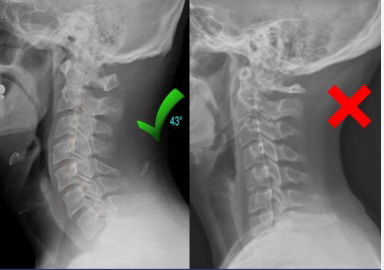Doctor, What is "Text Neck"?
What is Text Neck?
Text neck is a term used to describe the neck pain and damage caused by looking down at your electronic devices (Mainly Mobile Phones) for prolonged periods.
It's a common problem in today's digital age, especially with the widespread use of smartphones, tablets, and laptops.
What Causes Text Neck?
Text Neck is caused by the strain on the neck muscles and spine from constantly bending forward to look at screens.
When you tilt your head forward to use your device, it puts extra weight and pressure on your neck, leading to discomfort and pain over time. ( Check the pic below)

How Does Text Neck Affect Your Body?
Text neck can lead to various symptoms and health issues, including:
1. Neck Pain: The most common symptom of text neck is persistent pain or stiffness in the neck and shoulders.
2. Headaches: Straining your neck muscles can cause tension headaches that radiate from the base of your skull.
3. Poor Posture: Constantly looking down at screens can contribute to poor posture, leading to long-term spinal misalignment and muscle imbalances. ( See how the Curvature Changed. Leading to poor Biomechanics)

4. Nerve Damage: Prolonged pressure on the nerves in your neck can cause tingling, numbness, or weakness in your arms and hands.
Who is at Risk for Text Neck?
Anyone who spends a significant amount of time using a Mobile Phone is at risk for Text Neck.
However, certain factors can increase your likelihood of developing this condition, including:
1. Frequent Device Use: People who use smartphones, tablets, or laptops extensively throughout the day are more susceptible to text neck.
2. Poor Ergonomics: Using devices in awkward positions or without proper support can exacerbate neck strain.
3. Lifestyle Habits: Sedentary lifestyles and lack of physical activity can weaken the muscles that support the neck, making them more prone to injury.
4. Chronic Diseases: People with diabetes or Arthritis are more prone to text neck
Doctor How Can I Prevent Text Neck?
Preventing text neck involves making conscious changes to your device usage and posture habits.
Here are some tips to help you avoid or alleviate text neck:
1. Maintain Good Posture: Sit or stand up straight with your shoulders back and your head aligned with your spine. Avoid slouching or hunching over your devices.
2. Take Breaks: Take frequent breaks from your devices to stretch and rest your neck muscles. Aim to look up and away from your screen every 20-30 minutes.
3. Use Ergonomic Equipment: Invest in ergonomic accessories such as a laptop stand, ergonomic keyboard, or adjustable chair to support proper posture while using your devices.
4. Hold Devices at Eye Level: Instead of looking down at your phone or tablet, hold it at eye level to reduce strain on your neck muscles.
5. Practice Neck Exercises: Incorporate neck stretches and strengthening exercises into your daily routine to improve flexibility and muscle strength.
6. Limit Screen Time: Try to reduce the amount of time you spend on electronic devices, especially outside of work or essential tasks.
How Can Text Neck be Treated?
If you're already experiencing symptoms of text neck, there are several treatment options available to help alleviate discomfort and prevent further damage:
1. Rest: Give your neck muscles a break by avoiding activities that exacerbate pain, such as prolonged device use or heavy lifting.
2. Ice and Heat Therapy: Apply ice packs or heat pads to the affected area to reduce inflammation and alleviate muscle tension. ( Ice if Acute, Heat if Chronic )
3. Pain Medication: If pain doesn't decrease then your Doctor may add Painkillers with Muscle Relaxants to decrease the muscle tension.
4. Physical Therapy: A physical therapist can teach you exercises and techniques to improve posture, strengthen neck muscles, and alleviate pain.
6. Modalities: UST or TENS-like equipment after advice from a Doctor is also useful.
Doctor, what are the Long-Term Effects of Text Neck?
Untreated text neck can lead to chronic pain, decreased mobility, and increased risk of developing more serious spinal conditions over time. By addressing the underlying causes of text neck and adopting healthy device usage habits, you can prevent long-term damage to your neck and spine.
Conclusion
Text neck is a modern ailment that affects people of all ages who spend significant time using electronic devices. By practicing good posture, taking breaks, and incorporating ergonomic solutions into your daily routine, you can prevent text neck and maintain a healthy neck and spine for years to come.
If you're experiencing persistent neck pain or discomfort, consult with a healthcare professional for personalized treatment and advice.